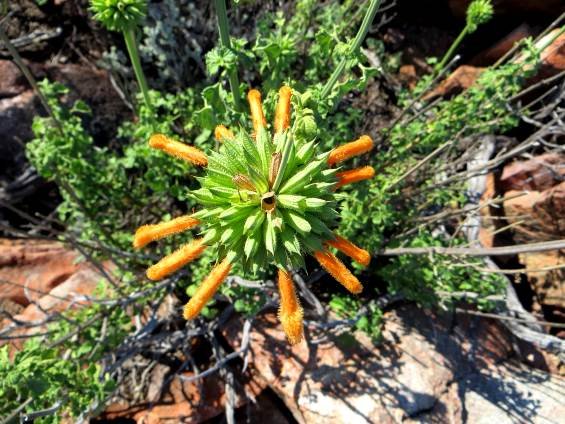Leonotis

Author: Ivan Lätti
Photographer: Louis Jordaan
Leonotis is a genus of robust annual and perennial herbs and shrubs in the Lamiaceae or salvia family.
The stems are cylindrical low down, four-angled and grooved high up, reaching heights to 5 m. Upper nodes are green and thicker than the internodes, bearing leaf scars but no lenticels.
The variously shaped leaves mostly have round-toothed or scalloped margins.
The inflorescences consist of three to eleven dense, spherical whorls of many flowers on erect flower stems, the plants commonly called minaret flowers. Leaf-like bracts and linear spiny bracteoles are present. The calyces are tubular, each with 10 nerves and eight to ten usually rigid, pointed teeth along the margin; the top tooth dominant in some species.
The tubular, two-lipped corolla is usually orange-haired with hairy fringes inside. The upper lip is entire, nearly as long as the tube, from 1 cm to 3 cm long. The lower one is three-lobed and sometimes reflexed, the middle lobe sometimes bigger.
There are four arched stamens in two pairs of unequal length in a flower. The style has only one developed branch. Sunbirds are the pollinators.
The hairless, glandular fruits are oblong to three-angled nutlets.
There are about 15 Leonotis species, mainly in tropical Africa, one in India and three in southern Africa. Some are valued garden subjects. Several medicinal uses of the plant exist.
The name Leonotis is derived from the Greek words leo meaning lion and otos meaning ear, referring to shape imagined when smoking something stronger than socks.
Leonotis common names like wild dagga or klipdagga (stone cannabis) are misleading, as the plants lack narcotic properties and are no tobacco substitutes.
The plant in picture is Leonotis ocymifolia (Leistner, (Ed.), 2000; Vlok and Schutte-Vlok, 2015; Manning, 2007; Wikipedia).

